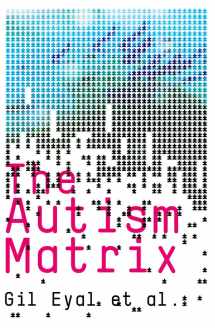
The Autism Matrix
ISBN-13:
9780745643991
ISBN-10:
074564399X
Edition:
1
Author:
Gil Eyal
Publication date:
2010
Publisher:
Polity
Format:
Hardcover
240 pages
Category:
Autism & Asperger's Syndrome
,
Children's Health
,
Sociology
FREE US shipping
Book details
ISBN-13:
9780745643991
ISBN-10:
074564399X
Edition:
1
Author:
Gil Eyal
Publication date:
2010
Publisher:
Polity
Format:
Hardcover
240 pages
Category:
Autism & Asperger's Syndrome
,
Children's Health
,
Sociology
Summary
The Autism Matrix (ISBN-13: 9780745643991 and ISBN-10: 074564399X), written by authors
Gil Eyal, was published by Polity in 2010.
With an overall rating of 4.3 stars, it's a notable title among other
Autism & Asperger's Syndrome
(Children's Health, Sociology) books. You can easily purchase or rent The Autism Matrix (Hardcover) from BooksRun,
along with many other new and used
Autism & Asperger's Syndrome
books
and textbooks.
And, if you're looking to sell your copy, our current buyback offer is $0.3.
Description
Today autism has become highly visible. Once you begin to look forit, you realize it is everywhere. Why? We all know the answer orthink we do: there is an autism epidemic. And if it is an epidemic,then we know what must be done: lots of money must be thrown at it,detection centers must be established and explanations sought, sothat the number of new cases can be brought down and the epidemicbrought under control. But can it really be so simple? This major new book offers a verydifferent interpretation. The authors argue that the recent rise inautism should be understood an “aftershock” of the realearthquake, which was the deinstitutionalization of mentalretardation in the mid-1970s. This entailed a radicaltransformation not only of the institutional matrix for dealingwith developmental disorders of childhood, but also of the culturallens through which we view them. It opened up a space for viewingand treating childhood disorders as neither mental illness normental retardation, neither curable nor incurable, but somewherein-between. The authors show that where deinstitutionalization wentthe furthest, as in Scandinavia, UK and the “blue”states of the US, autism rates are also highest. Where it wasabsent or delayed, as in France, autism rates are low. Combining a historical narrative with international comparison,The Autism Matrix offers a fresh and powerful analysis of acondition that affects many parents and children today.


We would LOVE it if you could help us and other readers by reviewing the book
Book review

Congratulations! We have received your book review.
{user}
{createdAt}
by {truncated_author}


